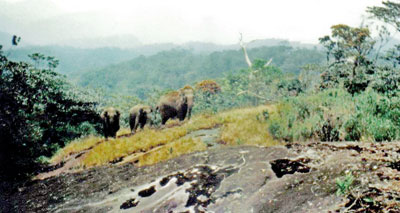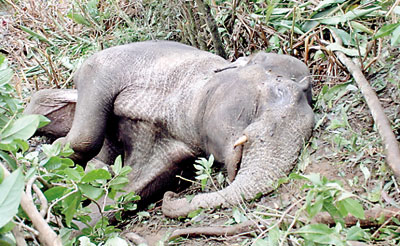News
Rare Sri Pada elephant yields valuable evolution clues
Last hideout of shy herd that survives by being elusive
Scientists are finding evidence of possible changes in evolution among elephants roaming Sri Pada with a chance to examine the body of an elephant found in the area in the first such sighting. The body was found last week (June 26) in the periphery of the Laxapana Tea Estate in Nallathanniya which adjoins the Peak Wilderness Wildlife Reserve, the last hideout of a dozen elephants that survive in the area.

The roaming herd in Siri Pada. Pic by Anil Vithanage
This is the first time the body of an elephant has been found here, and villagers flocked in large number to witness this rare scene.
The veterinary surgeon of the Elephant Transit Home (ETH) which oversees wildlife issues in the Peak Wilderness, Dr Vijitha Perera, said it appeared the elephant had been dead less than 12 hours, and that the death was due to natural causes. Dr. Perera, who performed the post-mortem on the elephant, told The Sunday Times that, interestingly, the elephant had fed solely on the small bamboos that grow in the Peak Wilderness. No grass was present in the gut.
The elephant’s jaw and ears, and overall the body, was smaller than elephants living in other areas. Dr Perera is of the view that these changes are a result of evolving adaptation to life in mountain terrain. The foot was smaller as well as smoother, unlike the cracked soles of an elephant in the Dry Zone.
The elephant also had well developed tushes (tushes are similar to tusks but do not grow more than a few inches). The white pigmentation on its body (known as kabara in Sinhala) made it look fairer. Dr Perera believes the dead elephant was at least 30 years of age.
The elephants in Sri Pada are elusive, said Nallathanniya Assistant Wildlife Ranger Anil Vithanage who has been studying this small elephant group for nearly a decade. He has been lucky enough to encounter the herd several times and was able to photograph it at Dharmaraja gala a few years ago. There were three sub-adults and a pregnant female in this herd, he said, allowing The Sunday Times use of the rare photographs.
Mr. Vithanage said the Sri Pada elephants roam a large area of the Peak Wilderness but are shy and keep their distance from humans. This has so far spared them from becoming casualties of human-elephant conflict. Fortunately, he said, the local people hold the animals in respect because the elephant is considered to be the bearer of lord Sumana Saman, the deity watching over Sri Pada (Samanala Kanda) Adaviya. Legend says that the devastating floods of 2002 were triggered by a curse over the killing of a Sri Pada elephant for its tusks.

A rare scene: The body of the elephant. Pic by Dr. Vijitha Perera
The elephants avoid the main areas during Sri Pada Pilgrim season and return to the range during the off-season as the noise of the pilgrims recedes.On the wilder pilgrimage paths through Kuruwita/Eratne and Palabaddala there can be seen signs of elephants that had passed through the area.
Mr. Vithanage said climbers who scale Sri Pada in the off-season for pilgrims were disturbing the silence enjoyed by these animals. Proposals such as setting up a lighting system to the peak as well as a cable car system should be considered with care in this extremely sensitive environment.
The Peak area was “a dense and trackless forest, the home of elephant, leopard, and bears” according to an 1862 missionary account. Huge herds were chased away as the Brititsh established plantations in the mountains. To protect the crops and for sport, thousands of elephants roaming the hill country and Wet Zone were killed.
The Peak Wilderness is now a UNESCO World Heritage site for its Natural Wealth and the remaining few elephants are the jewel of Peak Wilderness’ biodiversity. A conservation plan to protect them for future generation is a clear necessity, say environmentalists.
And then there were two …
The Sinharaja is home to just a couple of elephants in the Wet Zone, and they are probably the last of their generation. A few years ago, three elephants were spotted roaming in areas such as Pothupitiya, Ilumbakanda and Rakwana but Runakanda Friends of Biodiversity Association President Amila Chanaka says only two were spotted during the past year.
Unlike the Sri Pada elephants, the Sinharaja elephants are in conflict with villagers. They have claimed the lives of a few people in the area and in return, have been shot. Mr Chanaka worries that the missing jumbo was a casualty. He said all the elephants were males, so they are the last of their generation.
The remaining forest patches in these areas have been encroached on, mainly for tea cultivation, so the elephants have to pass populated areas, risking confrontation with humans. Relocation is virtually unfeasible as there are not sufficiently large Wet Zone habitats for these animals.
An attempt to relocate one of the Sinharaja elephants was blocked by some local villagers who take pride in the presence of the elephants. They say illicit liquor makers and timber fellers want to get rid of the elephants in order to carry out their activities undisturbed deep in the forest.
Follow @timesonlinelk
comments powered by Disqus

